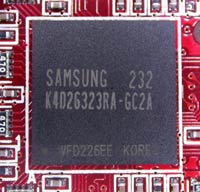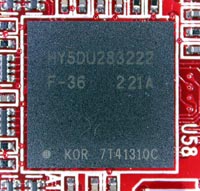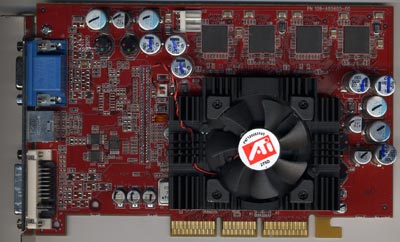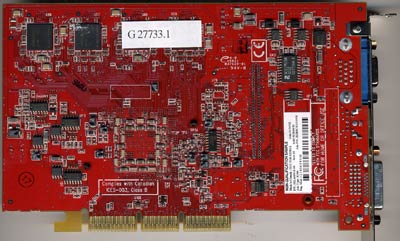
Original Link: https://www.anandtech.com/show/1041
ATI's Radeon 9500 Pro - Now Shipping & Faster
by Anand Lal Shimpi on November 27, 2002 6:00 AM EST- Posted in
- GPUs
Just over a month ago ATI introduced their Radeon 9500 Pro graphics card, a scaled down version of their flagship 9700 Pro. As is the case in today's graphics world, product announcements usually don't coincide with product shipments; this rule of thumb held true for the Radeon 9500 Pro.
The card was announced back in October and it will be in retail by the middle of December, but today ATI is announcing that they are beginning shipments of the 9500 Pro. In order to tide the market over until the 9500 Pro hits the streets, ATI has the Radeon 9500 to fill the gap but as we hypothesized in our first article - the 9500 won't be too competitive of a part.
The reason we're revisiting the Radeon 9500 Pro today isn't to commemorate its shipping status, but rather to look at the influences a redesigned board and shipping drivers will have on the final product. ATI told us at Comdex that the performance of the shipping Radeon 9500 Pro would be noticeably better than what we reviewed last month. How different is the shipping product? Let's find out...
Changes to the Card
We're not going to go through the architecture of the Radeon 9500 Pro or how it's derived from the R300 core, instead we'll point you back at our original Radeon 9500 article for more information on the chip and the card.
ATI made two physical changes to the Radeon 9500 Pro that differentiate it from the card we reviewed in October. The first change is that ATI has switched from Samsung memory (left) to Hynix memory (right).
 |
 |
This board also has a fully functional 128MB of memory as it is properly wired for the 128-bit memory bus of the Radeon 9500 Pro GPU.
The second difference is that the board layout has changed considerably; instead of using a Radeon 9700 Pro layout (the original cards were built on Radeon 9700 boards), the 9500 Pro uses its own design as you can see in the pictures below.
The majority of the performance differences come from a new driver that is shipping with the card. The driver improves performance across the board on the 9500 Pro and also works on the 9700 Pro. Performance isn't really enhanced on the 9700 Pro however, in some cases it's faster in others it's slower.
The final Radeon 9500 Pro driver does not work properly with the first Radeon 9500 Pro board we received, nor does it work with the Radeon 9500 (4-pipeline version). The current Radeon 9500 boards are still based on a design oddly reminiscent of the original Radeon 9500 Pro board we received, we don't see a reason for ATI not using the new board design on the regular Radeon 9500 unless they don't plan on keeping the card around for too long.
The Test
|
Windows
XP Professional Test Bed
|
|
|
Hardware
Configuration
|
|
| CPU |
Intel
Pentium 4 2.80GHz
|
| Motherboard |
Intel
D850EMV2
Intel 850E Chipset |
| RAM |
4
x 128MB PC1066 Kingston RIMMs
|
| Sound |
None
|
| Hard Drive |
80GB
Maxtor D740X
|
| Video Cards (Drivers) |
ATI Radeon 9700
(128MB) - CATALYST 2.3 |
Unreal Tournament 2003 Performance
With this review we introduce the final retail version of Unreal Tournament 2003 as a benchmark tool. The benchmark works similarly to the demo, except there are higher detail settings that can be chosen. As we've mentioned before, in order to make sure that all numbers are comparable you need to be sure to do the following:
By default the game will detect your video card and assign its internal defaults based on the capabilities of your video card to optimize the game for performance. In order to fairly compare different video cards you have to tell the engine to always use the same set of defaults which is accomplished by editing the .bat files in the X:\UT2003\Benchmark\ directory.
Add the following parameters to the statements in every one of the .bat files located in that directory:
-ini=..\\Benchmark\\Stuff\\MaxDetail.ini -userini=..\\Benchmark\\Stuff\\MaxDetailUser.ini
For example, in botmatch-antalus.bat will look like this after the additions:
..\System\ut2003 dm-antalus?spectatoronly=true?numbots=12?quickstart=true -benchmark -seconds=77 -exec=..\Benchmark\Stuff\botmatchexec.txt -ini=..\\Benchmark\\Stuff\\MaxDetail.ini -userini=..\\Benchmark\\Stuff\\MaxDetailUser.ini -nosound
Remember to do this to all of the .bat files in that directory before running Benchmark.exe.
|
Right off the bat we see some noticeable performance gains in UT2003 - 10% provided by the new driver and board optimizations.
|
The 9500 Pro is now finally right on the heels of the Ti 4600, where it should have been all along.
|
We finish off the flyby tests with the 9500 Pro coming within 7% of the Ti 4600.
Unreal Tournament 2003 Performance (continued)
The first part of the UT2003 benchmark focuses on GPU performance without taking into account physics and AI calculations that occur during normal gameplay. Thus the flyby scores on the previous page were very GPU bound; the botmatch benchmark in UT2003 is much more focused on physics/AI performance, both of which are tasks that are very CPU intensive.
The nature of the benchmark yields much lower scores and is obviously much less influenced by GPU performance. A faster CPU or chipset generally results in the most dramatic improvements here.
|
We kept the Radeon 9700 Pro drivers the same and used the new drivers for the Radeon 9500 Pro to illustrate a point in this benchmark. The new drivers clearly are the cause for the massive 20% increase in performance in UT2003; Botmatch is mostly CPU and driver limited, which is why we see such a big performance gain here. With the shipping 9500 Pro drivers, the two 9700 cards perform just slightly better than the 9500 Pro.
|
The trend continues, all of the ATI cards have at least a 10% advantage over the fastest GeForce4.
|
Where fillrate and memory bandwidth limitations come into play, the Radeon 9500 Pro's new driver cannot keep it on top for much longer. What's interesting to note is that the new driver doesn't change Radeon 9700 performance much at all, but has a huge impact on the Radeon 9500 Pro.
Comanche 4 Performance
We rarely benchmark with flight simulators for a handful of reasons but mostly that they are usually not very demanding on GPU power and are limited by CPU performance. It is also very difficult to find repeatable benchmark capabilities within most flight simulators; timedemo-like functionality isn't something that's normally built in.
Novalogic's Comanche 4 was an exception to the latter and thus we started using it in our reviews. The graphics aren't incredibly stunning but having another genre represented in our reviews never hurts.
|
Once again we stuck with the drivers you can find online for the Radeon 9700 Pro to prove the same point about the influence of the new Radeon 9500 Pro drivers - they are clearly responsible for turning the performance around for the 9500.
|
Here the Radeon 9500 Pro is slightly faster than a Ti 4600; you can thank the new drivers for the 18% increase in performance over the original card we tested.
|
Serious Sam 2 Performance
Croteam's Serious Sam games have been a favorite of ours not only because of their use of high quality textures but also because of their highly configurable engines. The team has always been one to try to adopt as many new features as possible into their games and thus we benchmark with everything enabled (with the exception of Truform and Anisotropic filtering):
|
The Radeon 9500 Pro doesn't benefit as much under Serious Sam 2, but there is a small increase thanks to the optimized driver.
|
|
Codecreatures DirectX 8.1 Benchmark
Codecult's Codecreatures engine has been turned into a fairly interesting DirectX 8.1 benchmark. Without widespread use of the engine this test ends up being no better than a synthetic benchmark, but it's interesting to see the results to help get an idea for how these cards perform under intense DirectX 8.1 applications.
|
Once again we see that the shipping Radeon 9500 Pro is able to hold its own with the Ti 4600.
|
|
AA & Anisotropic Filtering Performance
We introduced Anti-Aliasing + Ansiotropic filtering performance tests in our Radeon 9700 Pro review and we're continuing them here.
We ran a subset of our benchmarks with the following settings for the Radeon 9x00 series:
- 4X AA
- 8X Quality Anisotropic Filtering
The GeForce4s were run with these settings enabled:
- 4X AA
- 8X Anisotropic Filtering
If you're wondering about image quality or performance individually, read our Radeon 9700 Pro review where we cover those issues and more for both the ATI and NVIDIA GPUs.
|
|
AA & Anisotropic Filtering Performance (continued)
|
|
Final Words
ATI is very concerned about making sure the Radeon 9500 Pro is a success, as it targets a much larger volume price point. Thanks to an improved driver, new board design with an optimized layout and a full 128MB of memory the card is able to compete with the GeForce4 Ti 4600 instead of being just barely faster than the Ti 4200.
Getting this card to market in time is crucial for ATI, because although NV30 (GeForce FX) was delayed - both NV31 and NV34 are on track for their scheduled release. NVIDIA's NV31 will be what's pitted against Radeon 9500 Pro but we'll have to wait and see about the performance of NVIDIA's as yet unannounced part.
If ATI can indeed get their Radeon 9500 Pro cards out in quantity before the end of the year they will have at least a 2 month lead on NVIDIA. Putting pressure on NVIDIA in this ~$200 market segment combined with their uncontested Radeon 9700 Pro, ATI has truly proven their ability to deliver on promises - a welcome change from the ATI we saw during the days of the 8500.
Should NVIDIA be worried? Every day that they don't have competing products out in the channel is another opportunity to increase ATI's sales, we'll leave that decision to the market and you.









